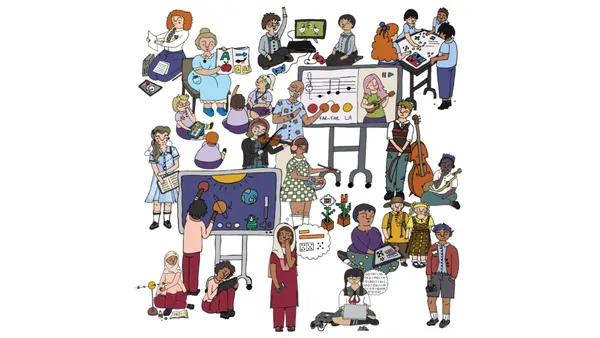Ray Bordwell is Global Head of Architecture at Whittle School and Studios.
A loud bell rings. Hundreds of students walk through narrow, windowless corridors into classrooms. They take their seats in neatly arranged rows of desks under cold fluorescent lighting.
This depiction of a school would have been accurate in 1959 or 1989
— and is unfortunately too often the norm in 2019. School buildings haven't changed much in the past half century. Their outdated design is hurting students.
Over the past 50 years, malls, hospitals, airports and nearly all other large buildings have modernized to reflect advancements in architecture and technology. Yet school design has in many ways remained static. The dominant form is a large-scale masonry egg carton with parallel, 25-person classrooms linked by long hallways.
Despite research showing certain design principles can bolster student achievement, the majority of schools have been slow to modernize. Teaching can take place in the worst environments imaginable. Closets become offices. Stairwells become music rooms. Copy rooms become small-group tutoring spaces.
While it's true "a great teacher can teach anywhere," there's no denying that the way we design and construct school facilities significantly influences student success and teacher performance.
Consider the importance of fresh air. Enclosed, poorly ventilated classrooms can trap students' breath, leading to a carbon dioxide buildup that inhibits alertness and concentration.
Or take the value of properly designed classroom acoustics, which limit background noise and enhance voices. Acoustically optimized rooms may arrange furniture in the best way for students and teachers to see and hear each other — or include carpets, porous ceiling tiles and curtains that dampen sound waves.
Even the colors of walls and floors affect learning. "Cooler" colors like blue and green increase relaxation and concentration. And by mimicking the natural outdoor aesthetic of dark earth and light sky that our eyes are accustomed to, dark-colored floors with light-colored ceilings improve focus.
Research also shows that classrooms with lots of natural light cause students to attend school more frequently, behave better and earn better grades. Offering people views of the outdoors reduces stress levels and lengthens attention spans.
High ceilings in classrooms spur creativity and a sense of freedom. Students in rooms with high ceilings have better memory recall and apply more abstract thinking to solving problems, according to a study published by the Journal of Consumer Research.
Design can even help bolster school curricula. Modern school curricula predominantly favor left-brain modes of thinking — that is, logic and analysis. Fewer courses reinforce right-brain thinking, which is associated with aesthetics, imagination, creativity and design.
Until schools balance out their curricula, what better way to stimulate the right brain than to design beautiful classrooms? That should be a priority for anyone who designs and builds a school facility.
Designing well-lit, airy, flexible classrooms isn’t a new idea. Crow Island School, which opened near Chicago in 1940, purposefully gave every classroom a view of a large forest adjacent to the property. To support the work that takes place in classrooms, the Ørestad Gymnasium high school in Copenhagen, Denmark, which opened in 2005, has large, flexible spaces where groups of various sizes can work together or individually.
Schools have the money to invest in innovative spaces like these. America spent an estimated $100 billion on education construction in 2018, reported the magazine School Planning & Management.
As the great educationalist William Alcott wrote in his 1832 "Essay on the Construction of School-Houses," "Every object, and every individual we see, either renders us more cheerful and happy or the contrary." That same principle applies today.
Is your school designed to be a 21st century school? Every modern student, parent and educator has a responsibility to ask that question.











